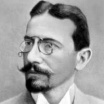Person of day - 5 MARCH 2024
SIEGBERT TARRASCH

One of the world’s strongest grandmasters during the late 19th and early 20th centuries was gripped by chess in high school. Tarrasch quickly achieved success at tournaments and in the 1890s, he joined the group of candidates for the world championship. Steinitz wrote that “Tarrasch is perhaps the greatest chess genius who ever existed.”
While Steinitz may have exaggerated the German’s talent, his ability was impressive nonetheless. Tarrasch was highly thought of by both contemporaries and respected champions such as Fischer and Kasparov. The German grandmaster won large tournaments and matches against Pillsbury and Marshall. But he could not overcome Chigorin. Their match in St Petersburg in 1893 finished as a draw.
In 1908, a long-time dream of Tarrasch came true- he played a match for the world championship against Emmanuel Lasker. The latter was evidently stronger and won the game with 8 victorious rounds and 3 losses. Tarrasch was meant to play for the world championship earlier, but he did not enter the fight for the supreme title because he worked as a doctor and he could not abandon the practice for long durations.
After the defeat by Lasker, he had to abandon dreams of the chess crown. But he performed at tournaments for many years, until the end of the 1920s. He played against the world’s strongest chess players- for example, he defeated Capablanca at the St Petersburg tournament in 1914, when the Cuban was at peak condition- and he demonstrated a thorough understanding of chess strategy.
Tarrasch is considered a follower of Steinitz. He was orthodox in his outlook, but multiple generations of chess players were raised on his advice and admonitions, which were expressed in aphorisms like “knight on the edge of the board stands badly”. And his great phrase- “chess, like music and love, can make people happy”- has stood apart from its author for many years.
Tarrasch proved himself as a significant theoretician. His analysis of the Queen’s Gambit led to the “Tarrasch Defence”, which was implemented by Spassky, Kasparov and other grandmasters. His chess textbooks, written more than a century ago, remain popular and relevant to this day.
The outstanding grandmaster and pedagogue, the “teacher of the chess world”, Tarrasch died in 1934 in Munich.























